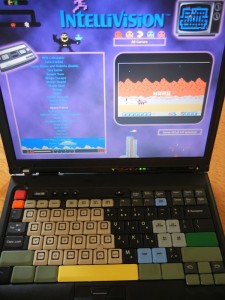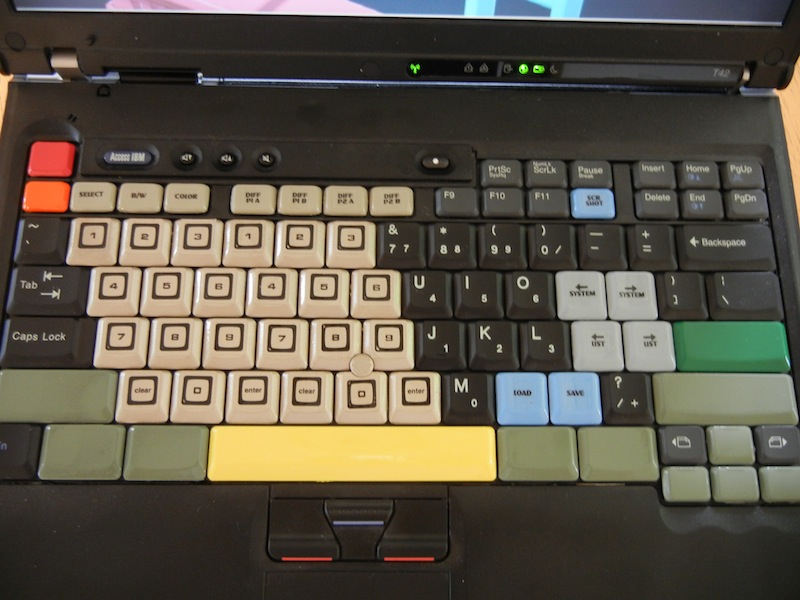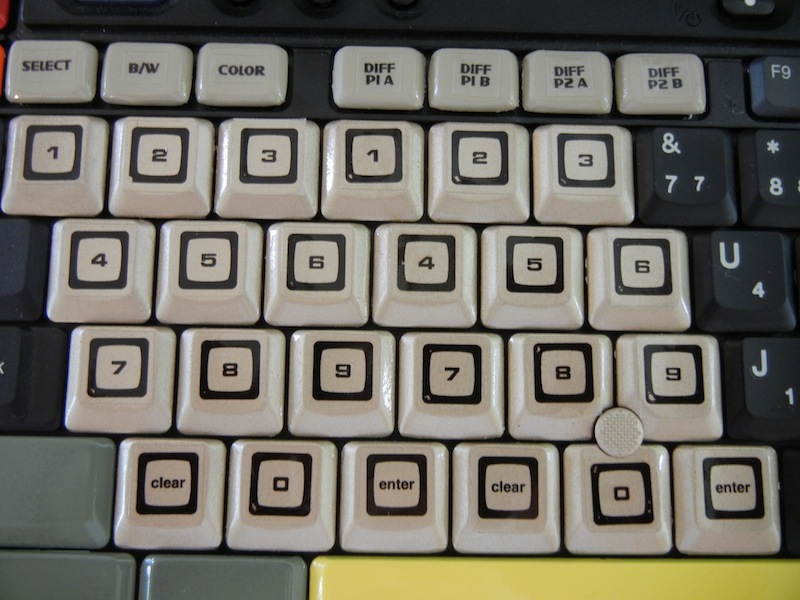I’ve created a second retro gaming emulation project. Kind of a little brother to my arcade cab, the Frinkiac 7. So I’m calling it the Frinkiac 6. It’s a laptop dedicated to emulating all the old consoles that I wished I had as a kid, plus a few more. It currently emulates the following consoles:
- Atari 2600 (via Stella)
- Odyssey 2 (via O2em)
- Intellivision (via jzintv)
- ColecoVision (via MESS)
- Atari 5200 (via MESS)
- Vectrex (via MESS)
- Atari 7800 (via MESS)
- Nintendo Entertainment System (via Nestopia)
- Sega Master System (via Fusion)
- Super Nintendo Entertainment System (via zsnes)
- Sega Genesis (via Fusion)
I’m using MAMEWah for the front-end, mainly because I’m very familiar with it from my arcade cab project.
Project goals
The real goals for this project were the following:
- I wanted a little portable console system that would play console games. That will allow me to remove those systems from the arcade cab (where they aren’t getting much play).
- I wanted to be able to hook the system up to a modern TV. My memories of playing these old games are of sitting on the floor or couch in front of a TV. I’ve got VGA and sound patch cables for connecting it to my HDTV, as well as a little converter box to allow it to connect to a composite input on a regular modern TV.
- I want to get as many original controllers for the systems as I can. For some that will mean some kind of interface to connect original controllers to USB on the laptop. For others, something close will do – e.g. I’m using Gravis gamepads as the controller for most of the more modern systems.
- I wanted to have dedicated keys to control the features of the emulators on the laptop. E.g. when you’re playing a game, it should be dead simple to pause it, to save state, reset the console, etc. I decided to tackle that by painting and labeling dedicated keys on the keyboard.
The controls on the keyboard are (loosely) color-coded. The light blue keys are for doing save/load and taking a screenshot while in a game. The grey keys are for moving around in the front-end: moving from list to list and from system to system. The green enter key starts a game from the front-end. The pale green keys provide minimal control for player one in all the games. The yellow space bar is a pause button. The red escape key exits games. The orange button will reset the console. The little tan function keys at the top correspond to the 6 switches on the original Atari 2600.
Controls
At the time of this posting, I’m using the following as controls for the various systems.
Atari 2600: I have two reproduction Atari 2600 joysticks that connect to USB from www.legacyengineer.com. I’m also working on retro-fitting two sets of Atari paddles to connect to USB as well.
Update: Well, I’m sorry to report that the joysticks from legacy engineer aren’t really working reliably. I got them as soon as they were available, so maybe they had some production issues with the first couple of batches (?). At any rate, these sticks aren’t going to work for my setup. And I doubt legacy engineer will want to support them since they are old (I don’t blame them). So it looks like the best route to take (once I get some cash) is to buy two Stella Adapters which will allow hooking up original Atari joysticks and paddles.
In the mean time, we’re using Gravis gamepads for the Atari games, which is working just fine.
Further update: I wrote the above after reading the official support policy as outlined on legacyengineer.com. But when I emailed their support, I was told to send them back for a quick repair! That’s very cool!. Hopefully they’ll be more reliable after a quick tune-up.
Last update: I’m sorry to report that even after getting my sticks repaired by legacyengineer.com, they still aren’t working reliably. I’ve moved on to using a Stella Adapter. Unfortunately, these aren’t for sale anymore at atariage.com (or they don’t seem to be ???), but I was able to grab a used one from gamegavel.com. I’m currently looking for a second one.
Odyssey 2: I’m just using the Atari joysticks for the Odyssey 2 games.
Intellivision: I have a CGC (Classic Game Controller) that was sold by Shiny Technologies a few years back. They connect original Intellivision controllers to USB. I also have mapped 24 keys on the keyboard to the keypads of the controllers so that simpler USB controllers (game pads, joysticks, etc.) can be used to play Intellivision games.
ColecoVision: I don’t have a really great solution for the ColecoVision controller yet. Currently, I’m just planning on using the Gravis gamepads and the Intellivision keyboard mappings for the keypads. I never liked the ColecoVision controllers, so I view this as a slight improvement anyway.
Atari 5200: The Atari 5200 is a bit of a weird system, in that it had analog sticks (that were pretty bad, as I understand it). So this system might only do well with a PC gamepad that has analog hats on it. I’m not 100% sure how I’ll get this working in a good way yet.
Vectrex: I’ll use the Gravis gamepads for the Vectrex. It isn’t a system I played much as a kid, so having authentic feeling controls isn’t a huge deal to me.
Atari 7800: Probably the Gravis gamepads again. Although the Atari 2600 joysticks will probably work for a lot of these games as well.
NES: At this point I’m using the Gravis gamepad for NES games, but I think as soon as I can find the spare cash I’ll spring for an NES-to-USB adapter so that original controllers can be used. I played a bit of NES in the late 80’s/early 90’s so the authentic feel of that system is a little more important to me than it is for other systems.
SMS: I’ve never played on a real SMS, so I’ll just use the Gravis gamepads for this system.
SNES: Gravis gamepad is a strong possibility here as well – it is nearly identical to the SNES controller anyway. But this is another candidate for possibly getting a dedicated USB converter in the future.
Genesis: I’ve never played on a real Genesis, so I’ll just use the Gravis gamepads for this system.
The Intellivision keypads
My favorite retro-console is definitely the Intellivision. I’ve written stuff about it on other sections of this site. It was important to me that this multi-console machine be able to play Intellivision games well.
Many Intellivision games will play very well with just a joystick and a button or two, lending themselves to either an Atari joystick or a gamepad for good gaming. However, even those games typically have a startup screen asking for number of players, or some other setting that required input from the keypads. That’s where my dedicated keys on the keyboard for the Intellivision keypads come in. A big thank-you goes to Joe Zbiciak for getting me clean graphics of the button numbers.
At the top of that picture, you can also see the buttons to support the Atari 2600 switches.
Thanks!
A couple of thank-yous: As mentioned above, thanks much to Joe Zbiciak for the cool little graphics of the Intellivision keys. Also thanks to David Harley for the Intellivision fonts that I used on all the wording on the keytops.
Of course I need to thank the hard work that the hobby communities put into creating emulators and dumping roms from the various systems’ carts as well as the man who created MAMEWah, my front-end of choice (he goes by the handle “min-wah”).


